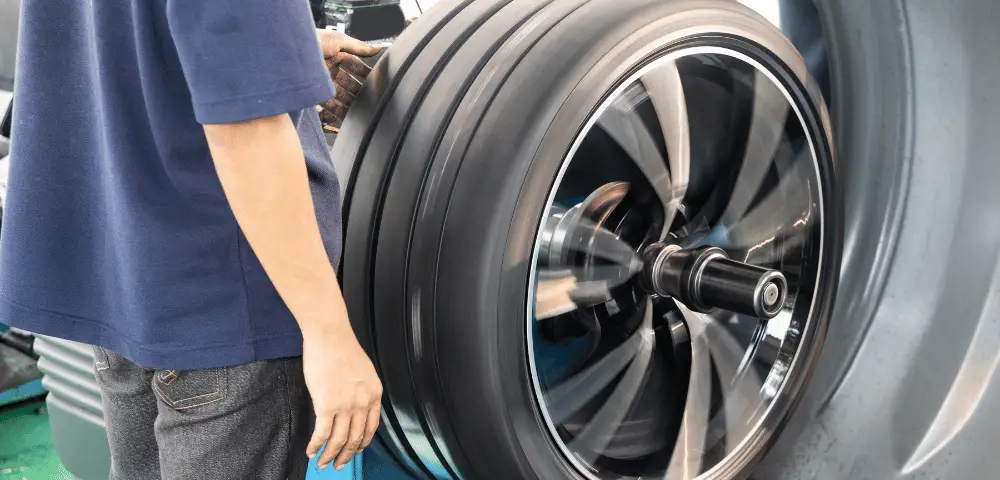Checking the balancing of your tires is a standard process all drivers and vehicle owners know about.
However, traditional balancing has its limits. It’s a simulation of how the tire will rotate on the road. But it doesn’t factor in the forces on the wheel.
Road Force Balancing overcomes these limitations. It considers several factors that can impact a spinning tire and allows you to get a perfect measure of how the tire will perform on the road.
Road Force Balance Explained
All tires have imbalances, even if their manufacturing is impeccable. These vibrations can significantly damage your tires as they won’t wear down evenly, which is integral for a smooth drive.
While standard balancing may work on older cars, new vehicles don’t have much tolerance. Even the slightest deflection can create many problems down the line.
However, Road Force Balance is a technique that replicates the tire’s performance in different conditions.
It simulates actual road conditions by applying pressure on the wheel as it spins.
Furthermore, it also measures how much force is thrown off by the tire during its spin, which is ideal for ensuring the impeccable performance of the vehicle under all conditions.
Differences Between Road Forcing Balancing and Standard Balancing
Both standard and road force balancing achieve the same thing: reducing the overall vibrations in the wheel. Standard balancing, however, works by ensuring the even distribution of weights.
This works fine on older vehicles.
The reason primarily concerns how older vehicles’ wheel and tire assembly is performed. These vehicles have a lot of space between the wheels and the body.
More recent models, however, are more compact and don’t have enough space. This enhances the impact of minor deviations and vibrations that standard balancing can’t cater to.
Another huge difference between road force and standard balancing is corrective balance weights, also known as match mounting.
In standard balancing, the mechanic uses any tool to check the roundness and weight distribution of the tire.
On the other hand, road force balance integrates a computer to optimize this entire process and get the same or better results while using fewer weights.
Finally, one more important difference between road force balancing and standard balancing is the wheel and tire assembly optimization.
Utilizing the Road force Balancer process allows you to find the perfect wheel for your tires. Standard balancing, however, can’t achieve this optimization.
Why is Road Force Balancing Important
The reason is simple.
Road Force Balancing is among the most effective ways to reduce the vibrations in your wheels. These vibrations affect your overall driving experience and can damage your car in some cases.
A properly balanced wheel will put equal pressure on the tire and result in even wear, which is an ideal case and ensures both the longevity and performance of the vehicle.
Is Road Force Balancing Always Important?
Having your tires balanced is always essential but how it should be achieved is open to debate.
While it’s always recommended to perform road force balancing on new tires because it can catch any manufacturing defaults in the sidewall and other tire sections.
Furthermore, new tires aren’t tested on the road, and it’s important to simulate their performance in actual conditions.
Finally, low-profile tires where the distance between the tread and wheels is low must always get road force balanced. Reducing the height amplifies the flaws due to vibration and may affect your overall experience.
So, when exactly does road force balancing become overkill? It is a premium service, so there should be a measure of when it’s not needed.
There is no concrete answer to this question.
But you should know that older and high-profile tires with a lot of distance between the tread and wheel would work the same after standard balancing.
The Overall Costs of Road Force Balancing
Road Force Balancing is a premium service, and rightly so.
Things are either good, quick, or cheap. Therefore, road force balancing isn’t cheap at all. The process is relatively quick and effectively makes your driving experience better.
Depending on where you are, and the season, the overall cost can be anywhere between $25 to $30 for a single tire.
This is a huge step from regular balancing, which averages around $15 per tire.
Final Thoughts on Tire Vibrations and Road Force Balancing
No matter how much of a perfect tire you buy, there are bound to be vibrations because of the many factors involved.
Road force balancing is nevertheless an effective method to minimize the vibrations in the wheels because it caters to both static and dynamic equilibrium and ensures effective results.



